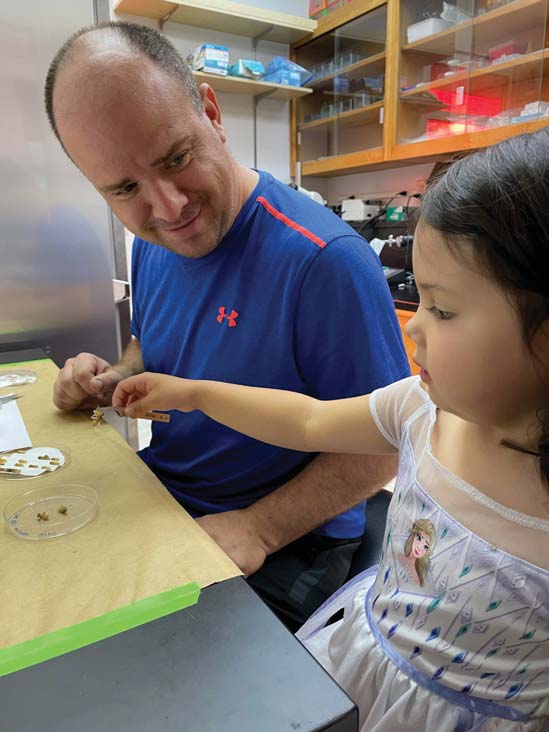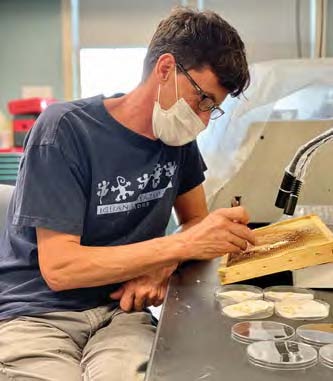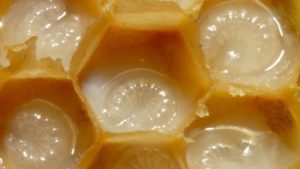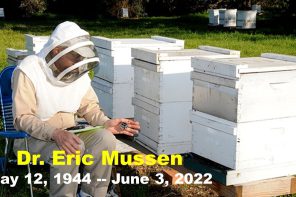More Signs of the Resistance
By: Jay Evans
I always like to start the New Year with hopeful signs for bees and beekeepers and am feeling optimistic right now that breeding efforts to control the disease impacts of parasitic mites are starting to have wide success. Controlling mite impacts on honey bees depends on several lines of attack, from effective breeding schemes for hygienic or mite-repelling bees to a battery of chemical and management controls. While nothing is permanent since the mites generally fight back, mite levels in wisely managed colonies are not much higher than they were in past decades. Still, the remaining mites seem to have a greater impact on colony health even when at low levels. This has shifted the blame to bee stress and disease as great hazards for bee losses. We know that Varroa mites move viruses around in bees, and that these same viruses are important for bee health. Why do the viruses moved by mites seem to cause more harm currently, and how can we deflect this viral curse?
Three recent studies suggest that bees are developing their own viral cures, either by actively decreasing virus loads or somehow learning to tolerate the viruses they carry in abundance. Barbara Locke and colleagues in Sweden and other European countries have been on the hunt for bees that live well with Varroa for many years. They recognized that bee survival in the face of these mites can reflect either direct attacks on mite fitness or tolerance for higher mite loads. For the latter, the sense is that survivor stocks deal with viruses moved by mites even while losing ground against the mites themselves. In a recent paper, Locke and teams from Sweden, Norway, the Netherlands, and France dug deep into the viral populations of bees known to be mite-resistant in each of those countries (Locke, B.; Thaduri, S.; Stephan, J.G.; Low, M.; Blacquière, T.; Dahle, B.; Le Conte, Y.; Neumann, P.; de Miranda, J.R. “Adapted tolerance to virus infections in four geographically distinct Varroa destructor-resistant honeybee populations.” Scientific Reports 2021, 11, doi:10.1038/s41598-021-91686-2.).
In the study, bees from all four survivor lineages tended to have slightly lower virus levels when fed equal virus amounts as larvae, when compared to a non-selected control population. Still, these results were largely non-significant, i.e., viruses (Deformed wing virus and Acute bee paralysis virus, both linked with mites) flourished in these survivor lineages. In fact, the most striking result from this study was not that survivor bees were better defended against viruses, but that they just went on with their lives even when heavily infected. All survivor lineages did better than standard bee populations when infected with viruses. This points to a tolerance effect by survivor bees, for both mites AND viruses. Perhaps these bees can keep viruses from invading vital body parts while not quashing infection entirely. Longterm survivor stock presumably holds a number of cards that are in play to limit the impacts of mites. This virus tolerance is perhaps a last line of defense when behavioral, colony-level, or physiological defenses are not quite enough.

Weaver Frame
Bees that are tough in the face of bee viruses are almost certainly a thing in the U.S. as well. This past month, I was lucky enough to be part of a published paper describing virus-fighting abilities of a mite-tolerant breeding line from Texas (Weaver, D.B.; Cantarel, B.L.; Elsik, C.G.; Boncristiani, D.L.; Evans, J.D. “Multi-tiered analyses of honey bees that resist or succumb to parasitic mites and viruses.” BMC Genomics 2021, 22, doi:10.1186/s12864-021-08032-z). This study began a decade ago, when queen breeder Danny Weaver, and his late father Binford Weaver, sent a few dozen colony samples from their beekeeping lines. These lines are never treated for mites so are analoguous to the four European survivor stocks in that way. The Weaver samples were divided into ‘susceptible’ and ‘resistant’ lines based on field traits, and all were fairly loaded with mites. They wanted to know what distinguished the survivors from the sufferers. What caught our interest was that the resistant bees had lower levels of both the mite-friendly Deformed wing virus and viruses that are not transmitted by mites….hinting at a more general trait of viral resistance.
We next pitted some of our local mite-susceptible stock against these Texas survivors. We found lower viruses overall in the Texas bees but also a much lower bump in virus levels when individual bees were parasitized as pupae by mites. Next up was an experimental infection of relatively clean (mite-free) pupal bees with Deformed wing virus, the main “plus-one” of parasitizing Varroa mites. We injected a virus dose or a control solution (salt water) into pupae from a range of breeder queens. Infected bees were followed for several days then sacrificed to measure virus levels as well as the suite of bee genes turned on in response to virus infection. Again, progeny from some queens kept virus levels in check while others gave in to high virus growth. We did not measure longterm bee health in our study but did subject infected and control bees to a battery of genetic tests to determine how they had reacted to virus exposure. Bees from resistant queens did seem to mount a better immune response when given a full virus dose. They also just seemed to drag their feet on activating genes indicative of the stress of viral infection, perhaps slowing virus growth as a consequence. In a humbling twist, some bees even from resistant stocks were highly vulnerable to these (admittedly strong) virus doses, suggesting that more can be done to push even mite-tolerant lines towards a stronger response against viruses.

Collecting injected bees.
New tools are being developed to help screen breeding stock for virus resistance and Michael Simone-Finstrom has used such tools as a main focus of his work in the USDA-ARS Honey Bee Breeding, Genetics, and Physiology Research Laboratory in Baton Rouge, Louisiana. In a paper led by postdoctoral researcher Hannah Penn (Penn, H.J.; Simone-Finstrom, M.; Lang, S.; Chen, J.; Healy, K. “Host Genotype and Tissue Type Determine DWV Infection Intensity.” Frontiers in Insect Science 2021, 1, doi:10.3389/finsc.2021.756690), these researchers injected young bees with various viral cocktails and then measured viral outcomes.
This study involved many of the key commercial bee lineages in the U.S.; ‘Carniolan’, ‘Italian’ and the mite-selected ‘Pol-Line’, “Russian’, and ‘Saskatraz’ lines. Surprisingly, there was no significant difference across stocks on the whole when bees were injected with Deformed wing virus. However, simply poking bees with control injections (salt water again) did lead to higher virus levels in some of the tested stocks versus others, suggesting that latent viruses were more risky in these stocks (you’ll have to read the paper to see how your favorites did).
This study also gives great insights into differences between the two predominant strains of Deformed wing virus in terms of how they differ in their infection means and possible impacts on bees. The two strains, ‘A’ and ‘B’ differ in the bee body parts they thrive in, and in how they interact with particular bee stocks. DWV Strain ‘B’, a recent and now widespread lineage in the U.S. also called Varroa destructor virus-1 (e.g., https://www.nature.com/articles/s41598-017-17802-3), was also both more aggressive during infection and more likely to emerge from latent infections in bees simply given the salt water injections. This is a bit ominous, and suggests that selection for breeding traits against viruses might have to account for an increasing diversity of viruses.
Viruses in both bees and humans are invisible and don’t always present symptoms that beekeepers, researchers, and doctors can detect. These studies took advantage of genetic viral signals and careful experiments to show that bees from different backgrounds have some of their own defenses in hand to deal with virus exposure. This is reason to be optimistic and it will be exciting to see how breeding programs that target the impacts of viruses on bees proceed.









